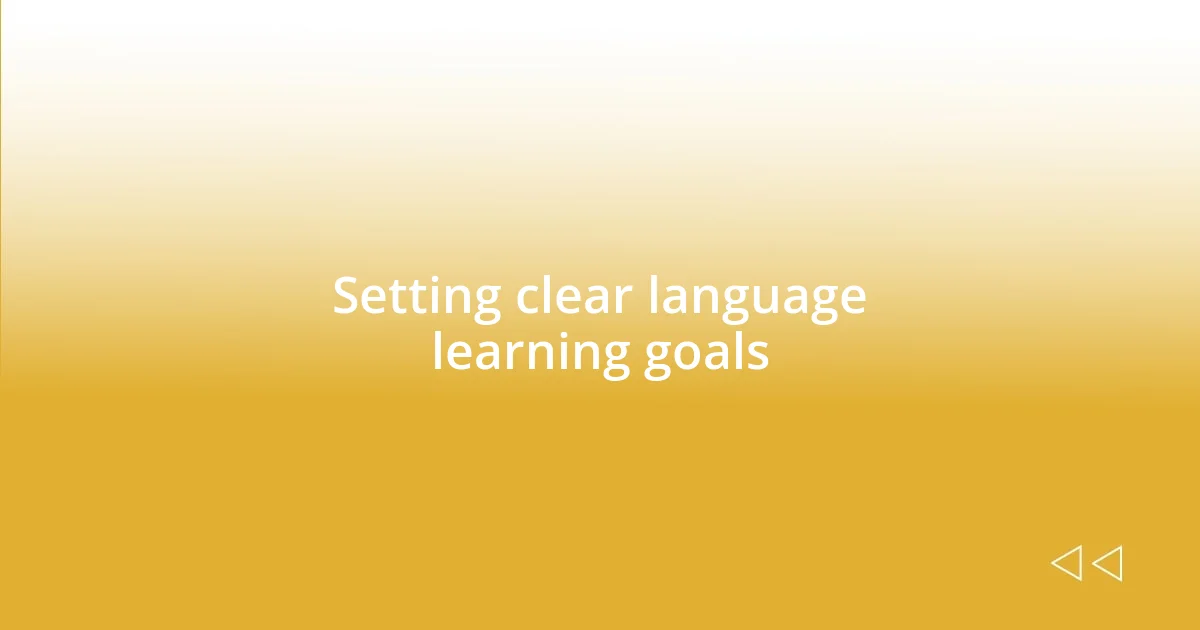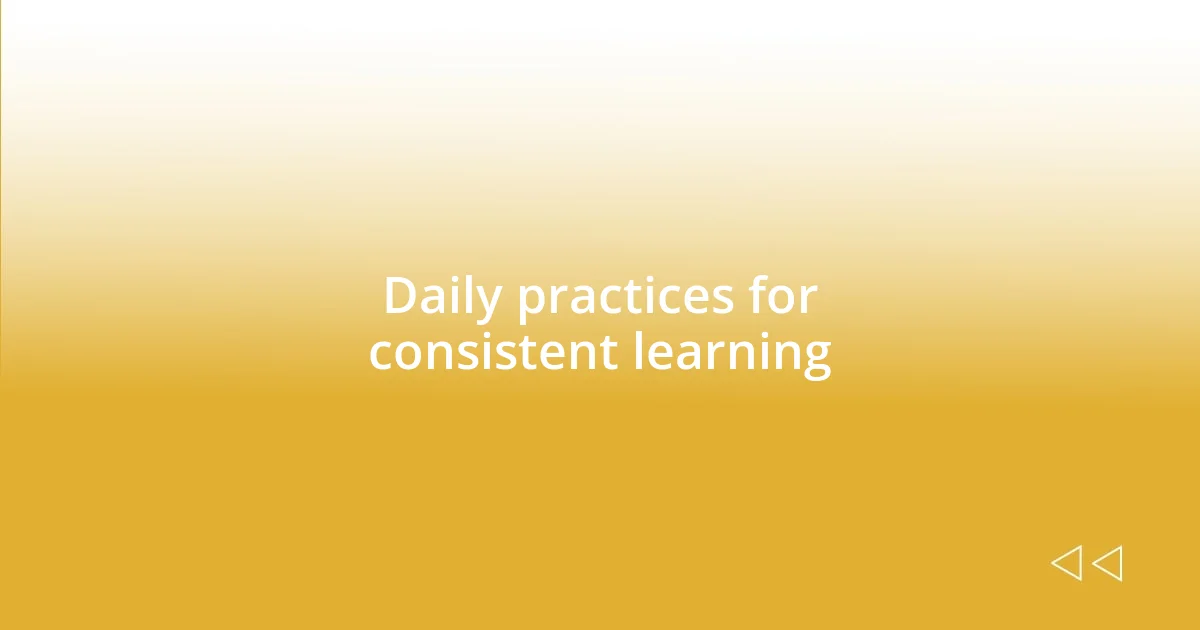Key takeaways:
- Setting clear language learning goals enhances focus and motivation, allowing for measurable progress through specific, achievable targets.
- Incorporating daily practices, even as brief as 15-20 minutes, contributes to consistent learning habits and integrates language study into everyday life.
- Engaging with the language community and utilizing app features (like reminders and forums) enriches the learning experience and fosters social connections.

Understanding language learning apps
When I first stumbled upon language learning apps, I was both intrigued and skeptical. Could something so digital truly aid in mastering a language? After exploring several options, I discovered that these apps are designed to cater to various learning styles—whether you’re a visual, auditory, or hands-on learner.
One of the standout features for me was the gamification element. It reminded me of the thrill I felt playing video games as a child—progress bars, points, and achievements made the learning process not just educational but invigorating. I often found myself wondering, “Why didn’t I start learning languages like this before?”
As I dived into my language studies, I noticed that the variety of exercises, from vocabulary quizzes to pronunciation practice, kept my motivation levels high. Pairing activities like speaking with a virtual tutor helped bridge the gap between theory and practical use. Can you imagine speaking the language in a real-life scenario? That vision kept me returning to the app, eager for more practice.

Setting clear language learning goals
When it comes to language learning, I’ve learned that setting clear goals is essential for progress. For instance, rather than saying, “I want to learn Spanish,” I specify, “I want to hold a 10-minute conversation in Spanish within three months.” This clarity helps me focus my efforts and track my achievements more effectively, which is incredibly motivating.
In my experience, breaking down larger goals into smaller, manageable tasks really enhances the learning process. For example, instead of aiming to master all the verb conjugations at once, I tackle one tense each week. Each small victory feels rewarding and keeps me engaged.
It’s also helpful to periodically reassess my goals. I remember when I first aimed for basic fluency, but as I progressed, I realized I wanted to delve deeper into the culture connected to the language. Adjusting my goals not only reflects my evolving interests but also keeps my learning experience fresh and exciting.
| Types of Goals | Examples |
|---|---|
| Short-term Goals | Hold a 10-minute conversation in 3 months |
| Medium-term Goals | Read a novel in the target language |
| Long-term Goals | Achieve fluency for work-related scenarios |

Daily practices for consistent learning
To build consistent learning habits, I find that integrating short, daily practices is key. When I first started, I was overwhelmed by the prospect of dedicating hours to language learning. However, I quickly discovered that just 15 to 20 minutes each day could yield substantial results. This manageable timeframe made it easier to stay committed, allowing me to fit learning around my busy schedule without feeling guilty about time limitations.
- I set a daily reminder on my phone, which nudged me at the same time every day, turning language learning into part of my routine.
- Engaging with the app during my commute transformed what used to be idle time into productive learning sessions.
- Mixing fun activities, like watching a show in my target language or listening to music, helped reinforce vocabulary without feeling monotonous.
- Incorporating a language partner for brief conversations boosted my confidence and added a social element to my practice.
Consistency, in my experience, is all about creating a rhythm that suits my lifestyle. I remember a period where I’d wake up 10 minutes earlier just to do a quick review of vocabulary. That little commitment made a world of difference! Over time, these practices started to feel less like chores and more like exciting rituals that jumpstarted my day.

Tracking progress and adjusting methods
Tracking progress is an aspect of language learning that I can’t emphasize enough. I vividly remember the moment I hit “check” on the achievement bar for my first level in an app; it felt like a mini-celebration! By regularly reviewing my achievements—be it through app stats, flashcard reviews, or even journal entries—I can see how far I’ve come. Don’t you find it motivating to see your hard work reflected in tangible results?
Adjusting my methods based on this progress tracking has been equally vital. If I notice that I’m struggling with vocabulary retention, I change my approach by incorporating different techniques. For instance, I once had difficulty with a set of words, so I started making silly mnemonics. Not only did it help me remember them, but it added a playful element to my learning. Have you ever tried mixing in a bit of humor to break through learning plateaus?
Finally, I find reflecting on my learning style helps refine my approach even further. I often ask myself, “Am I retaining this well, or is it time to try something new?” For instance, when I realized that solely using flashcards wasn’t as engaging for me anymore, I began to integrate more contextual learning methods, like language exchange meetups. It’s fascinating how tweaking the way I learn has opened new doors not just in skill acquisition but also in connecting with people who share my passion. What adjustments have you made that transformed your learning experience?

Engaging with the language community
Engaging with the language community has been one of the most rewarding aspects of my learning journey. I remember the first time I joined an online language exchange group; it felt like stepping into a vibrant world filled with native speakers and fellow learners. Just chatting with someone about their favorite movies in our shared language made me realize how connected we all are through our love for language. Have you ever felt that sense of belonging in a community?
I often take part in local meetups where we practice speaking in a relaxed setting. These gatherings are a treasure trove of insights—my language partner once introduced me to slang that’s not in textbooks. I was amazed at how much that casual conversation improved my fluency. It’s fascinating how real-life interactions can provide context and make the language come alive. Wouldn’t you agree that sharing a laugh while learning is the best way to solidify new knowledge?
Through social media, I’ve also connected with learners from around the globe, creating a network of support. I once posted a question about a tricky grammar rule and was amazed by the helpful responses I received—it felt like a mini-masterclass! Engaging with the community not only enriches my learning but also fosters friendships that extend beyond language barriers. Have you tapped into the potential of social media to enhance your language expertise?

Tips for maximizing app features
Maximizing app features involves diving deep into each tool the application offers. One feature that I cherish is the daily reminder option. The first time I set reminders, it felt like a supportive nudge to keep me on track. I recall one day when I almost skipped my session, but the gentle alert popped up, reminding me of my goals. Have you utilized reminders in your apps to develop a consistent habit?
Another essential tip is to explore social features within the app. I remember stumbling upon a forum section in my language app where learners shared tips and challenges. Engaging in discussions there opened my eyes to different learning strategies, and I even picked up a few idiomatic expressions that I wouldn’t have encountered otherwise. Have you found wisdom shared by others that has enriched your understanding of the language?
Lastly, I recommend leveraging the offline mode if your app offers it. During a long subway ride, I once downloaded several lessons to work on, and it transformed an otherwise dull commute into a productive learning session. It’s surprising how a bit of planned downtime can lead to positive progress. How do you maximize your learning opportunities even when on the go?















